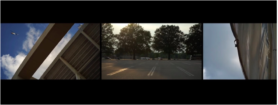Blog
Sensing cities and (in)securities
By Lotje Krouwel, Zaki Arrobi and Jolien van Veen
Lotje, Zaki and Jolien, PhD candidates in the SACRASEC research cluster at UU, organized a workshop on sensorial ethnography on June 7-8th 2021. Below is a brief summary of some of the issues we discussed.
What can sounds, images, smells, touch and taste teach us about how people experience (in)security in an urban environment? And how do religious institutions incorporate sensorial experiences in their everyday practices, particularly in the context of urban violence? While the speakers we invited for the workshop came from different academic backgrounds – sociology, visual anthropology, ethnomusicology, or urban studies – each of them contributed a unique piece of work that inspired us to think beyond sensory ethnography as merely a research tool. Through their videos, articles, and recorded book chapters it became clear that navigating cityscapes, (in)securities, and religious experiences are inherently multisensorial affairs.
The video by Veronika Kusumaryati and Ernst Karel titled Expedition Content (2020)[1] reflected on the complex encounter between wealthy American expedition leaders and the Hubula people in West-Papua. This encounter was shaped by particular ways of seeing, hearing, and touching which are in turn connected to a larger system of inequality and exploitation.

still from Jena Seiler’s film, Three Frames: Kroger Field
In a similar vein, Jena Seiler’s short film Three Frames: Kroger Field (work in-progress) illustrated how the interplay between sounds and images affects our experiences of space and place. Her film also raises the question: does the perspective from which we approach a space (looking through the eyes of a bird, for example) change the meaning that we ascribe to that space and if so, why? The short text by Alana Osbourne reflected on how our experiences of space may change in the aftermath of violence. After the bomb explosions in the city of Brussels in 2016, different neighborhoods were considered unsafe based on the images or smells that these neighborhoods evoked amongst a largely white, middle- and upper-class citizenry (Osbourne 2021).
Benjamin Tausig’s analysis of protest songs of the Red Shirt movement in Bangkok similarly illustrated how particular sounds and spaces are connected to periods of political unrest (Tausig 2019). However, Tausig also noted that sound offers an opportunity for people to engage in new, alternative constructions of power and authority.
Another sensorial aspect of authority, as James Edmonds suggested, is smell. Drawing on fieldwork conducted in Indonesia, Edmonds argues that focusing on the characteristics of smell – smells can pass, mix, or overpower someone – opens up new possibilities for understanding contemporary Islam beyond the binary of normativity vs. ambiguity (Edmonds 2019). On a more personal level, Edmonds further noted that smells do not evaporate once a researches leaves the field but they may stay with someone for a long time, taking them back to decisive moments of their fieldwork.
Finally, the work presented by Laura Keesman elaborated on the use of audiovisual material as a way to contextualize and to make explicit embodied understandings of police action vis-á-vis civilians and other officers (Keesman 2021). This methodological approach, as Keesman argues, allowed for a more precise and detailed account of how people use their bodies in relation to others, something that is particularly interesting in light of the SACRASEC discussions on how authority is (re)produced between security providers and their respective audiences.
Based on the material presented above, we discern three overlapping themes of doing sensorial ethnography in the context of urban (in)security. A first point of focus are the regulations surrounding sensorial experiences. How are sounds, images, smells, touch and taste regulated by, and connected to, systems of in- or exclusion? For example, which music are people allowed to perform in public spaces during protest marches? And which smells are attached to a particular socio-political or religious hierarchy? Regulations concerning the senses also serve as a reminder that ways of seeing, hearing, feeling, touching, and smelling are never neutral but are embedded in socio-cultural and historical contexts.
Second, as researchers we need to be attentive to sensorial disruptions, or in the words of Osbourne (2021, 45) sensory dis-orders: moments when a collection of sensorial experiences fails to ‘make sense’. For example, one could ask: how, when and why do sensory regimes shift across time and space? What do these shifts tell us about the (in)visible and (im)material boundaries between particular areas or neighborhoods? Third, it is important to consider vulnerabilities of ourselves and of our informants. How are we as researchers permeated by sensorial experiences in the field? How can we reflect on vulnerabilities that we, or our informants, have experienced? Taken together, the workshop showed the depth of research material that is out there when we start thinking and writing with our senses.
References
Edmonds, James. 2019. “Smelling Baraka: Everyday Islam and Islamic Normativity”. American Journal of Social Sciences 36:3.
Keesman, Laura. 2021. “Action Accounts of Police-Civilian Interactions: Using Video Elicitation to Explore Police Officers’ How-to Knowledge”. Poetics. DOI: https://doi.org/10.1016/j.poetic.2021.101561
Osbourne, Alana. 2021. “Experiencing Urban Violence: Cities, Sensory Regimes and Dis-orders”. Urban Violence. London: the British Academy.
Tausig, Benjamin. 2019. Bangkok is Ringing: Sound, Protest, and Constraint. Oxford: Oxford University Press.
[1] Unfortunately, the video is not publicly available but you can find more information about the project here: http://ek.klingt.org/expeditioncontent.html.

